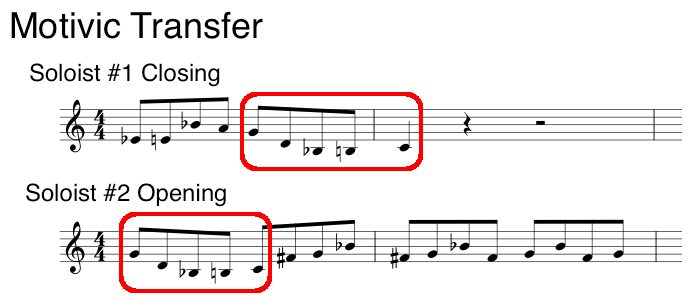Basic Elements of Music
So there are four basic elements of music:
- Melody (pitch, dynamics, intervals)
- Harmony (texture – homophonic, polyphonic, monophonic)
- Rhythm (beat, tempo, meter, duration, form)
- Timbre
Approaches to Improvisation
It’s possible to structure your improvisation around one of these elements. Doing so presents different ‘approaches’ to improvisation. These are listed below:
| Element | Approach | Example |
|---|---|---|
| Melody | Melody + Embellishment | New Orleans Jazz |
| Keys/Scales | Modal Jazz | |
| Motivic Development | Melody based: Sonny Rollins Non-melody based: Cecil Taylor |
|
| Harmony | Chords with alterations and substitutions | Coleman Hawkins Bebop |
| Rhythm | Rhythmic Groove | Latin Jazz (clave rhythm) |
| Timbre | Noise, Microtones, etc. | Free Jazz (John Coltrane) |
| External | Mood (Expressionism) | ‘Peace’ ~ Ornette Coleman |
| Scene (Impressionism) | ‘Lonely Woman’ ~ Ornette Coleman | |
| Culture/Political | ‘Riot’ ~ Herbie Hancock |
Historical Development of Improvisation
Since the beginning of Jazz, the preferred approach to improvisation has evolved.
- When Jazz first started in the early decades of the 1900’s (New Orleans and Dixieland Jazz) improvisation was just playing the melody with embellishments. Have a listen to King Oliver, Louis Armstrong, and Jelly Roll Morton.
- During the Swing Era, Coleman Hawkins (sax player with Count Basie’s Band) changed Jazz improvisation from melody based to harmony based. Instead of just embellishing the existing melody he created new melodies based on the song’s harmonic progression – by arpeggiating the chords with relevant extensions, alterations and substitutions.
- Bebop took this harmonic approach to improvisation and expanded it further – using more and more complex substitutions.
- The arrival of Modal Jazz caused a shift from this ‘vertical’ chord based improvisation approach, to a ‘horizontal’ scale based improvisation approach.
- At the same time, Jazz musicians began placing greater emphasis on Motivic Development in improvisation.
- Sonny Rollins returned to using the melody within this improvisation. But instead of just embellishing the melody, he took fragments of the melody as motifs and then developed them gradually through this solo, but constantly referred back to the motif.
- John Coltrane’s used the ‘Love Supreme’ motif in all 12 keys in the song Acknowledgement (on the album A Love Supreme). (Aside: The album ‘A Love Supreme’ is a deeply religious one for Coltrane. The use of the Love Supreme motif in all 12 keys is metaphorical. It signifies that God (the motif) is everywhere (in every key).)
- In Free Jazz, melodic motifs became increasingly important precisely because Free Jazz had largely rejected harmony. As such, it makes sense that Free Jazz songs are structure melodically (through the use of motivic development) rather than harmony (like most tonal songs).
- Miles Davis’ groups used a technique (let’s call it ‘Motivic Transfer‘) whereby the last phrase a soloist plays becomes the opening phrase and motif for the next soloist.

- In some genres of Jazz, rhythm or groove is more important than any other element.
- Afro-Cuban Jazz requires everyone (including the soloist) to adhere to the clave rhythm. (with the piano playing montunos) The actual notes you play are less important than the rhythm of the notes.
- Jazz generally swings, so should the soloist.
- Free Jazz also cause musicians (notably Coltrane) to experiment with the timbre of their instrument. Coltrane would use things like false fingerings, multiphonics, harmonics, microtones, and creating noise in his solos. Timbre became more important than any other element of music.
- Improvisations can be based on some external, non-musical factor.
- Peace ~ by Ornette Coleman is about peace
- Lonely Woman ~ by Ornette Coleman is about a lonely woman
- Riot ~ by Herbie Hancock is about the riots during the Civil Rights movement. Indeed, it was recorded two days after the 1967 Newark riots.
Over the history of Jazz the way musicians thought about improvisation has changed. this has given rise to a number of different improvisational approaches, all of which you can employ in your own improvisation. But do keep in mind that you may not be able to hear what approach the soloist is taking as a listener. These ‘approaches’ are just a way the soloist ‘thinks’ about his or her improvisation, nothing more.